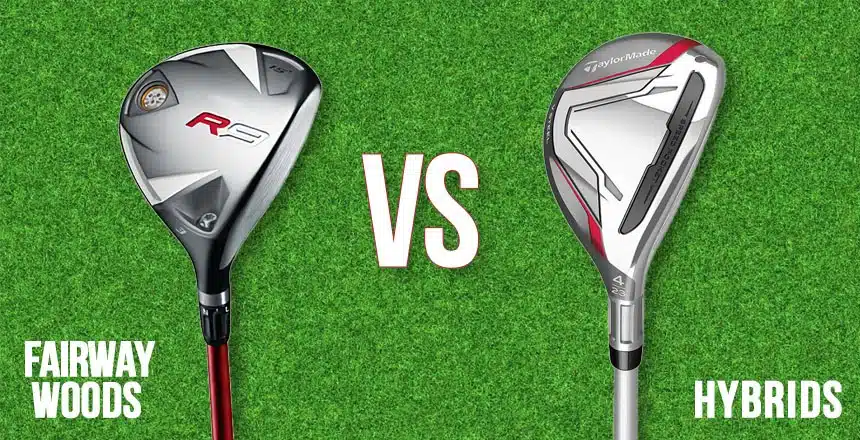|
Getting your Trinity Audio player ready...
|
With the ever-evolving world of golf equipment, players are faced with an array of options when it comes to choosing the right club for their game. One of the most debated choices is between the fairway wood and the hybrid.
Each club offers its own unique set of advantages and disadvantages, making the decision a difficult one for many golfers.
In this article, we will delve into the key features of both the fairway wood and the hybrid, weigh the pros and cons of each, and explore whether there is a middle ground between the two clubs.
When it comes to fairway wood vs. hybrid, there are several factors to consider. Fairway woods are designed to optimize distance and trajectory from the fairway, while hybrids are crafted to replace long irons with a more forgiving and versatile option.
Fairway woods typically feature a larger clubhead and a lower center of gravity, resulting in increased launch and distance.
On the other hand, hybrids offer enhanced ease of use, making them ideal for getting out of tough lies or hitting accurate shots from the rough.
Understanding the individual characteristics of these clubs is crucial in making an informed decision about which one will best suit your game.
FAIRWAY WOOD KEY FEATURES
When it comes to choosing the right club for your golf game, one important decision to make is whether to use a fairway wood or a hybrid. Both clubs have distinct features that make them suitable for different situations on the course.
Fairway woods, also known as fairway metals, are typically made of metal and have a larger head compared to a hybrid. This larger head provides a larger sweet spot, allowing for more forgiveness and better distance on off-center hits.
Fairway woods are great for long shots from the fairway or rough, as they offer excellent distance and control. However, they can be slightly more difficult to hit off the turf due to their larger size.
On the other hand, hybrids offer a combination of the features found in fairway woods and long irons. These clubs have a smaller head and shorter shaft, making them easier to control and hit off the turf.
Hybrids are designed to provide the distance of a fairway wood with the accuracy and precision of an iron. They are great for long shots from the fairway, rough, or even the tee.
Hybrids are also versatile, allowing golfers to hit a variety of shots from different lies.
In conclusion, when choosing between fairway woods and hybrids, it is essential to consider your playing style, skill level, and the specific situations you encounter on the course.
Both clubs have their unique advantages and disadvantages, and it ultimately comes down to personal preference.
So, take the time to test out different fairway woods and hybrids to find the club that suits your game best. Remember, finding the right club can greatly enhance your performance and enjoyment on the golf course.
PROS AND CONS OF FAIRWAY WOODS
Fairway woods are an essential part of any golfer’s arsenal. They offer great versatility and can be used in various situations on the course. One of the main advantages of fairway woods is their distance potential.
Compared to hybrids, fairway woods often provide more power and distance off the tee or fairway.
This is particularly beneficial when you need to cover long distances or reach the green on par 5 holes. Additionally, fairway woods have a larger clubhead, allowing for a larger sweet spot.
This increases the forgiveness and makes it easier to make solid contact with the ball.
However, one drawback of fairway woods is their lower degree of playability compared to hybrids. Due to the larger clubhead and longer shaft, fairway woods can be more challenging to control and maneuver, especially in tight situations or when trying to shape shots.
This is where hybrids often outshine fairway woods as they provide more precision and versatility in shot-making.
Another advantage of Fairway Woods is their ability to launch the ball higher and generate more backspin.
This can be advantageous when trying to land the ball softly on the green or when facing obstacles such as bunkers or water hazards. Fairway woods are also beneficial when playing from the rough.
Their larger clubheads and wider soles glide through the grass more efficiently, making it easier to get the ball out and onto the fairway. However, it’s worth noting that fairway woods can sometimes be less forgiving than hybrids when it comes to mishits.
For golfers who struggle with consistency or have a slower swing speed, hybrids may offer more forgiveness, making it easier to achieve optimal results.
Ultimately, the choice between fairway woods and hybrids comes down to personal preference, playing style, and the specific needs of each golfer.
Understanding the pros and cons of both options can help golfers make an informed decision when choosing their ideal club for different on-course situations.
Pros of Fairway Woods:
One of the main advantages of fairway woods is their versatility on the golf course. Fairway woods are designed to be hit from the fairway, as the name suggests, but they can also be used off the tee or from the rough. This makes them a valuable club to have in your bag, as they can be used in a variety of situations and can help you navigate different course conditions.
Another benefit of fairway woods is their distance potential. Fairway woods typically have a larger clubhead and longer shaft than irons, which allows for greater power and distance.
This makes Fairway Woods an excellent choice for players who struggle to generate enough clubhead speed with their irons. Additionally, fairway woods can also be easier to hit off the ground than longer irons, providing a higher degree of forgiveness and allowing for greater accuracy in approach shots.
Overall, Fairway Woods offers golfers the ability to hit long and accurate shots from various lies on the golf course. In the ongoing debate of hybrid vs. fairway wood, fairway woods certainly hold their own when it comes to distance and versatility. However, it’s important to consider your playing style and preferences when choosing between these two clubs.
Cons of Fairway Woods:
While fairway woods have their advantages, there are a few drawbacks to consider. One of the main issues is the difficulty in achieving maximum control and precision with these clubs. Unlike hybrid woods, fairway woods have larger heads, making it more challenging to make precise shots. This can be particularly problematic for players who prefer a more precise and controlled swing.
Additionally, fairway woods might not be suitable for players who struggle with hitting the ball cleanly. These clubs have a low center of gravity, which means they are more prone to digging into the ground if not struck properly. This can result in mis-hits and inconsistent shots.
On the other hand, hybrid woods have a lower center of gravity, allowing for better contact and reducing the chances of digging into the ground.
Understanding the difference between fairway woods and hybrid woods is crucial when deciding which club to use. While fairway woods provide more distance, they might not offer the same level of control and versatility as hybrid woods.
It’s important to consider your playing style, skill level, and personal preferences when making a decision. Experimenting with both types of clubs during practice sessions can help you determine which one suits your game best.
HYBRID GOLF CLUB KEY FEATURES:
A hybrid golf club is a versatile club that combines the best features of both irons and fairway woods. It is designed to offer more forgiveness and distance, making it an ideal option for various situations on the golf course.
The hybrid club is typically used for long shots from the fairway or rough, as well as for approach shots to the green.
Its design allows for a lower center of gravity and a larger sweet spot, which helps in achieving a higher launch trajectory and more consistent ball striking.
The shape of a hybrid wood golf club is slightly different from a traditional fairway wood, with a smaller head and a shorter shaft, providing better control and maneuverability.
One of the key features of a hybrid golf club is the ability to replace long irons, which are usually more challenging to hit consistently.
With the hybrid club, golfers can experience improved distance and accuracy, especially on shots that require more loft.
The combination of the wood-like design and iron-like performance makes the hybrid club a valuable tool in a golfer’s arsenal.
Additionally, the versatility of a hybrid club allows players to effectively navigate various course conditions, making it an excellent choice for both amateurs and professionals alike.
PROS AND CONS OF HYBRID GOLF CLUBS
Hybrid golf clubs offer a range of benefits that can improve a golfer’s game. One of the notable advantages is their versatility.
With a combination of features from both fairway woods and long irons, hybrid clubs provide players with a middle-ground option.
The design of a hybrid wood allows for better control, accuracy, and distance compared to long irons while offering more forgiveness and higher launch angle than fairway woods.
This versatility makes hybrids an excellent choice for various shots, such as hitting off the fairway, rough, or even navigating tricky lies.
Additionally, the technology employed in hybrid clubs allows for wider sweet spots, promoting better contact and performance on mis-hits.
CONS OF HYBRID GOLF CLUBS
While hybrid golf clubs have their advantages, they may not be well-suited for everyone due to a few drawbacks. One such concern is the potential difficulty in shaping shots.
The design of the clubhead, which is focused on forgiveness and playability, may limit a player’s ability to work the ball or intentionally shape shots.
Moreover, some golfers may find it challenging initially to adjust to the feel of a hybrid club, especially if they have been accustomed to the solid, traditional feel of long irons.
This adjustment period may require practice and getting used to the different swing dynamics associated with hybrid clubs.
Pros of Hybrid Golf Clubs:
Hybrid golf clubs offer several advantages over traditional fairway woods, making them a popular choice for many golfers. One of the main pros of hybrid golf clubs is their versatility.
They are designed to combine the best characteristics of both long irons and fairway woods, allowing golfers to have more confidence and control in their shots.
Whether you need to hit the ball off the tee, navigate through the rough, or even play a long approach shot, hybrids can provide the perfect balance between distance and accuracy.
Moreover, hybrid golf clubs are known for their forgiveness. The innovative design of these clubs, with a larger sweet spot and lower center of gravity, helps golfers achieve better results even when they don’t hit the ball perfectly.
This forgiveness can be particularly beneficial for high handicappers or those who struggle with consistent ball striking.
Additionally, hybrids are often easier to launch into the air compared to fairway woods, making them a great choice for players with slower swing speeds or beginners who are still developing their technique.
Overall, hybrids offer a reliable and effective solution for golfers seeking a versatile and forgiving club that bridges the gap between fairway woods and long irons.
Cons of Hybrid Golf Clubs:
There are a few drawbacks to consider when it comes to hybrid golf clubs. First, some players may find it challenging to control the trajectory of the ball with hybrids.
Unlike fairway woods, hybrids have a more upright face angle and shorter shaft, which can lead to a higher ball flight. While this can be beneficial in certain situations, it may not suit everyone’s playing style or desired ball flight.
Another potential downside is that hybrids may not offer the same distance as fairway woods. Due to their design, hybrids typically have a shorter shaft length, resulting in less clubhead speed and potential distance.
Players who rely on long shots and require maximum distance off the tee may find Fairway Woods to be a better option.
Ultimately, the decision between a hybrid or fairway wood boils down to personal preference and individual playing style.
It is essential to assess your specific needs on the golf course and consider factors such as ball flight, distance, and overall control.
Additionally, trying out both types of clubs during practice sessions or seeking advice from a professional club fitter can provide valuable insights to make an informed decision.
IS THERE A “MIDDLE GROUND” BETWEEN FAIRWAY WOODS AND HYBRIDS?
In the world of golf, there has always been a debate about the use of fairway woods versus hybrids. Golfers often find themselves torn between the two options, wondering if there is a “middle ground” that offers the perfect combination of distance and control.
Both the wood and hybrid golf clubs have their unique features and advantages, making it challenging to determine which one is best suited for individual players.
Fairway Woods is known for its ability to provide maximum distance off the tee and fairway. With larger clubheads and longer shafts, they generate more power and allow golfers to achieve greater yardage.
On the other hand, hybrids offer a balance between the fairway wood and an iron, combining the forgiveness and versatility of an iron with the distance and ease of hitting a wood.
They feature smaller clubheads and shorter shafts, making them easier to control and launch the ball high into the air with accuracy.
The decision between wood vs. hybrid and hybrid vs. fairway ultimately depends on the golfer’s personal preferences, playing style, and skill level.
Some golfers may prefer the traditional feel and power of fairway woods, while others may find hybrids more forgiving and easier to hit.
It is essential to consider factors such as swing speed, trajectory control, and shot-shaping abilities when choosing between the two.
Golfers are encouraged to test out both club types and seek advice from professionals to determine the best fit for their game.
HOW DO I CHOOSE ONE CLUB OR THE OTHER?
One of the key factors to consider when choosing between a hybrid and a fairway wood is the difference in loft.
Fairway woods generally have a lower loft compared to hybrids, which means they are better suited for long shots off the tee or from the fairway.
On the other hand, hybrids have a higher loft, making them ideal for shots from the rough or when you need more height and distance.
Another important aspect to consider is the forgiveness level of each club. Fairway Woods are known for their larger clubheads, which offer a larger sweet spot and more forgiveness on off-center hits.
Hybrids, on the other hand, have a smaller clubhead size similar to that of an iron. This smaller size allows for more precision and control but may result in less forgiveness on mishits.
By understanding the difference between hybrid and fairway wood in terms of loft and forgiveness, you can evaluate your playing style and determine which club is the better fit for your game.
Keep in mind that it may be beneficial to have both options in your bag and use them accordingly based on the specific shot and course conditions you encounter.
HOW TO CHOOSE WHAT YOU NEED BETWEEN A HYBRID AND FAIRWAY WOOD
When it comes to deciding between a hybrid and a fairway wood, there are a few key factors to consider. Firstly, think about your skill level and the type of player you are.
Fairway woods tend to be better suited for experienced golfers who have a higher swing speed and can generate more distance.
On the other hand, hybrids are often favored by beginners or those with a slower swing speed, as they provide more forgiveness and easier launch.
Another important factor to consider is the type of shot you want to achieve. Fairway woods are typically used for longer shots from the fairway or tee, offering a higher trajectory and more distance.
Hybrids, on the other hand, are great for versatility and can be used in various situations, including hitting shots from the rough or getting out of tricky lies.
By assessing your preferred shot type and the various scenarios you may encounter on the course, you can determine which club will better suit your needs.





